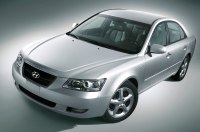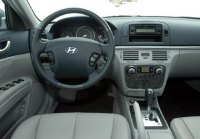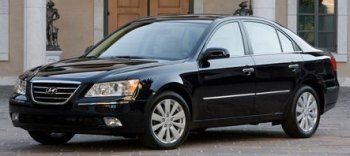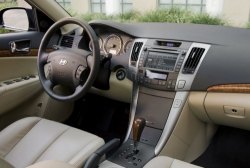|
Hyundai Sonata
Debut: 2005
Maker: Hyundai
Predecessor: Sonata (1999)
|
|
 Hyundai
wants to be the world's fifth largest car maker by 2010. To do this,
it should not only sell a large number of small cars but also have a
bigger slice of the mid-size car segment. This is especially crucial
to its largest overseas market, the USA, where mid-size cars are the
biggest selling class. To fight against class leaders Toyota Camry
and Honda Accord, Hyundai invested some US$250 million into the new
generation Sonata, an unheard figure for Korean cars. It will also be
produced in the USA for the first time at a brand new factory. The
combined volume of the American and Korean factory will be 300,000
Sonatas a year. Hyundai
wants to be the world's fifth largest car maker by 2010. To do this,
it should not only sell a large number of small cars but also have a
bigger slice of the mid-size car segment. This is especially crucial
to its largest overseas market, the USA, where mid-size cars are the
biggest selling class. To fight against class leaders Toyota Camry
and Honda Accord, Hyundai invested some US$250 million into the new
generation Sonata, an unheard figure for Korean cars. It will also be
produced in the USA for the first time at a brand new factory. The
combined volume of the American and Korean factory will be 300,000
Sonatas a year.
From
the pictures, the new Sonata does not look like that ambitious. Its
exterior styling is conservative or even boring. So lack of new ideas
and inspiration that it looks like, well, just a car. The same goes
for the mechanical layout. Following its Japanese rivals, Sonata
adopted a front-drive, transverse engine layout with a choice of a
4-cylinder and a V6 engine. 5-speed manual gearbox or 4-speed auto
for the smaller engine and 5-speed auto for the V6. Nothing caught
our attention.
 The car measures 4.8 m in
length, 1.83 m in width,
1.475 m in height and have a 2730 mm wheelbase. In other words, the
same size as Camry and Accord. Open the doors and you will find much
the same room as its rivals, thus five adults should sit comfortably
on the well-shaped, if slippery, leather seats. However, the Hyundai
is cheaper than the Japanese cars and this is immediately revealed by
its cabin – not only the design is dull, it employs cheap-looking
ungrained plastics at the center console and glovebox. They are easy
to scratch, and easy to scratch you by their rough edges. In other
words, cabin quality is sub-standard. The car measures 4.8 m in
length, 1.83 m in width,
1.475 m in height and have a 2730 mm wheelbase. In other words, the
same size as Camry and Accord. Open the doors and you will find much
the same room as its rivals, thus five adults should sit comfortably
on the well-shaped, if slippery, leather seats. However, the Hyundai
is cheaper than the Japanese cars and this is immediately revealed by
its cabin – not only the design is dull, it employs cheap-looking
ungrained plastics at the center console and glovebox. They are easy
to scratch, and easy to scratch you by their rough edges. In other
words, cabin quality is sub-standard.
The
Sonata has
a chassis rigid enough. It also
employs high-spec suspensions: the front wheels ride on
double-wishbones and the rear on multi-link setup. Hyundai used to
employ very soft setup to please American, but now with the addition
of the American production plant it can employ stiffer setup for
market elsewhere, including Korea and Europe. This is also the
version we talk here.
With stiffer springs and
dampers, the new Sonata
feels sportier than Camry, if not Accord. It still understeer a lot –
blame to the high-profile tires – but it rolls little in corner.
Unfortunately, this is in the price of ride quality. In fact, Sonata
is one of the worst riding cars in this class. It sends shocks from
bumpy surfaces to the cabin accompany with a lot of suspension noise
and road noise. Hyundai still hasn't handle the know-how of NVH
suppression.
 Comparatively, the engine department
is much
better. Both engines are newly developed. The “Theta” 2.4-litre
4-cylinder is a joint-venture among Hyundai, DaimlerChrysler and
Mitsubishi. It has many good technologies, such as all-alloy
construction, twin-cam 16 valves, continuous variable valve timing,
variable length intake manifolds and twin-balancer shafts. It
produces 161 hp and 161 lbft of torque, virtually the same as Honda
and Toyota's counterparts. Though neither the smoothest nor the most
eager to rev, the Theta delivers a satisfying combination of power
and refinement. Mated with a manual gearbox, the Sonata can
accelerate to 60 mph in a competitive 8.4 seconds. Comparatively, the engine department
is much
better. Both engines are newly developed. The “Theta” 2.4-litre
4-cylinder is a joint-venture among Hyundai, DaimlerChrysler and
Mitsubishi. It has many good technologies, such as all-alloy
construction, twin-cam 16 valves, continuous variable valve timing,
variable length intake manifolds and twin-balancer shafts. It
produces 161 hp and 161 lbft of torque, virtually the same as Honda
and Toyota's counterparts. Though neither the smoothest nor the most
eager to rev, the Theta delivers a satisfying combination of power
and refinement. Mated with a manual gearbox, the Sonata can
accelerate to 60 mph in a competitive 8.4 seconds.
The 3.3-litre “Lambda” V6
is
also brand new.
It employs aluminum block, twin-cam 24 valves, continuous VVT and
variable intake like the smaller engine. 233 horsepower is more than
enough for a Korean family car, especially when the additional 300 cc
over the Japanese rivals gives it superior torque. The V6 mated with
a 5-speed automatic accelerates to 60 mph in 7.5 seconds, faster
than Camry.
Therefore, in terms of
performance and engines the
Sonata is competitive. In terms of driving fun, there is hardly any.
Although roll resistance is quite good, the Sonata is no match with
the American Accord in handling, let alone the smaller Ford Mondeo,
Mazda 6, Volkswagen new Passat and the European Honda Accord. Size is
a problem, so is understeer and numb steering feel. Besides, the car
is so lack of inspiration, no matter in design and the way it drives.
However, those buying
Korean
cars are unlikely to
be excitement seeker. The biggest problem to the Sonata is poor
quality and refinement. It shows that Hyundai is not yet in a
position to match the Japanese and European car makers. |
| The
above report was last updated on 7 May 2005. All
Rights Reserved. |
Sonata facelift 2008
|
 Facing newer and
stronger rivals in the
US market, such as new Honda Accord, Mazda 6, Nissan Altima, Toyota
Camry and Chevrolet Malibu, Hyundai Sonata is struggling for survival.
The 2009 model year facelift, which went on sale recently, could ease
its pain. It deals with the biggest weaknesses of the outgoing car,
namely dull design and cheap cabin. Facing newer and
stronger rivals in the
US market, such as new Honda Accord, Mazda 6, Nissan Altima, Toyota
Camry and Chevrolet Malibu, Hyundai Sonata is struggling for survival.
The 2009 model year facelift, which went on sale recently, could ease
its pain. It deals with the biggest weaknesses of the outgoing car,
namely dull design and cheap cabin.
We start from the exterior look. The facelift brings Sonata a more
upmarket front end design. Although you can describe it as conservative
and even outdated (think about an old Acura RL), it is at least a neat
effort. Moreover, conservative may be not a bad thing to the old
customers Hyundai is targeting at. That said, the Sonata is still one
of the least attractive looking cars in the field.
 Inside, the improvement is more obvious.
The old Sonata had a very ugly and cheap-feeling ungrained plastic
dashboard and console. It used to be a strong reason to skip this car,
although it has one of the roomiest cabins in the class. Now the
completely redesigned console and dashboard looks much more decent in
style and quality. It won't frighten its established Japanese and
European rivals or the new Chevrolet Malibu, but it is no longer a
negative point of the car. Inside, the improvement is more obvious.
The old Sonata had a very ugly and cheap-feeling ungrained plastic
dashboard and console. It used to be a strong reason to skip this car,
although it has one of the roomiest cabins in the class. Now the
completely redesigned console and dashboard looks much more decent in
style and quality. It won't frighten its established Japanese and
European rivals or the new Chevrolet Malibu, but it is no longer a
negative point of the car.
In response to competition, Hyundai uprated both engines by adopting
dual variable-valve timing (previously only at the intake valves). The
2.4-liter four-cylinder "Theta" engine now produces 175 hp instead of
161 hp, while the 3.3-liter "Lambda" V6 pumps out 249 hp instead of 233
hp. They provide satisfactory performance, refinement and fuel economy.
Again, nothing is special.
The weakest link is still ride and handling. Despite of a stiffer
suspension setup (in American version), it still falls behind its
modern rivals in body control, steering and damping. Its chassis does
not feel as rigid, and its suspension kinetic does not feel as
sophisticated. This mean Sonata will continue to miss keen drivers in
its customer portfolio. Its most powerful weapon is still value for
money. |
| The
above report was last updated on 29 Jun
2008. All Rights Reserved. |
|
|